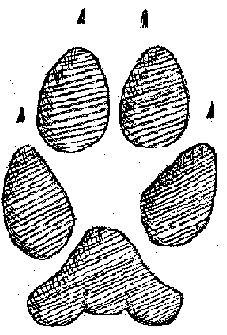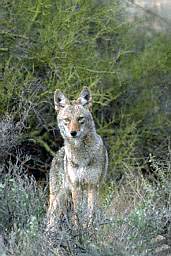Coyotes. . .

Given half a chance, this crafty critter can make a fool out of the most experienced caller on the planet, let alone someone new to the sport of calling.

Coyotes vary in size depending on the area where you find them. Coyotes found in the Southwest deserts normally weigh from 20 to 30 lbs., while their cousins in the higher and northern elevations can weigh as much as 50 lbs. or more. Ounce for ounce, the coyote is perhaps the most efficient predator/scavenger to ever walk this land, as he continues to expand his territory.
Coyotes mate in the early spring (late February - March) the pups are born some 63 days later. Both the male and female take a very active role in raising the pups and it's not uncommon for other pack members to get involved in raising the pups too.
I myself make it a practice to stop calling when the coyotes enter the mating season and don't beginning calling until late fall. This concept gives the coyote population a chance to raise their young unmolested from hunting pressure and insures plenty to critters to call in the future. This self-imposed calling season has worked well for me over the years and I always urge all predators callers to please do the same.
Now getting to the subject of calling coyotes. . .
Finding areas to call coyotes is a never ending quest, depending on were you live, this task can be a piece of cake or an adventure in itself.
Coyotes are social animals and they are very vocal about it. A good caller will use these traits to help locate a good area to call coyotes. Coyotes are territorial critters, meaning they like to cut out a certain piece of real-estate and call it home, and they don't like strangers roaming around in their backyard.
Next to hunting up their next meal, coyotes spend a great deal of time cruising the boundries of their home range, looking for signs of intruders, and marking their territory. To mark the boundries of their territory, coyotes establish scent posts that they visit routinely and will urinate and leave scat to warn other coyotes to stay out of the area.
What all this activity amounts to is basically a NO TRESPASSING - KEEP OUT sign for coyotes. All this may not sound like much to us humans but to coyotes. . .this is a very big deal. A caller looking for coyotes must keep a sharp eye out for these scent posts, or markers, for a coyote will update these locations with new scent frequently. Be sure to check old roads, trails, and ridge lines for coyote droppings with accompanying srcatch marks made by the hind legs. You find this and your in coyote country for sure.
Of course finding coyote tracks is a sure indication of coyotes, but in some areas, dogs are common too, so relying on tracks to find coyotes in some situations can be misleading, especailly back East.



Running out of space here, for more information on coyotes. . . click the link to Coyotes Part II.